VOLVO XC90 2013 Owner´s Manual
Manufacturer: VOLVO, Model Year: 2013, Model line: XC90, Model: VOLVO XC90 2013Pages: 310, PDF Size: 8.62 MB
Page 51 of 310
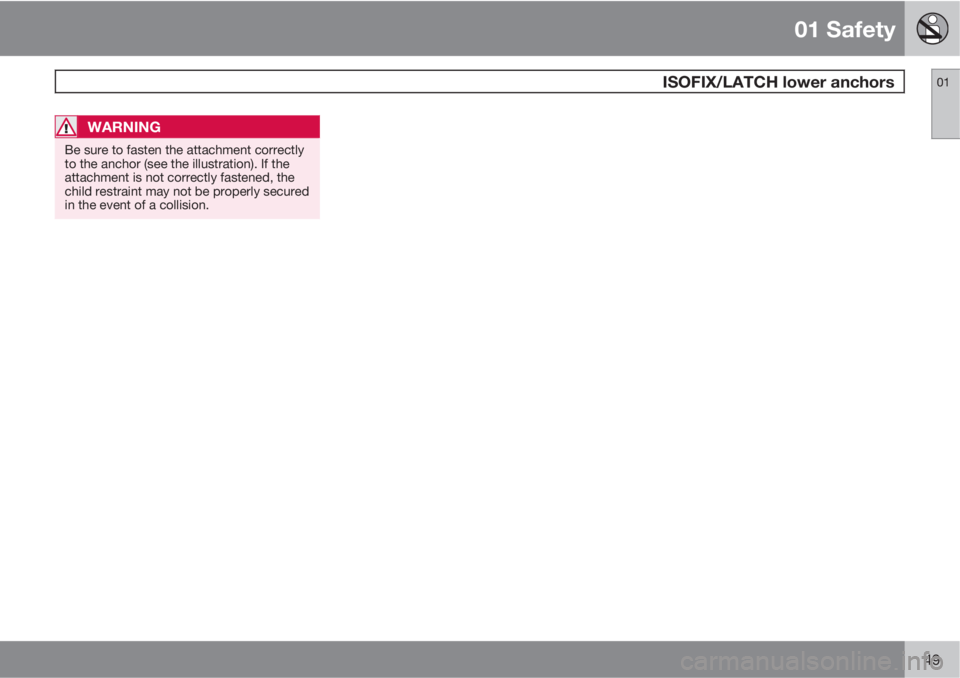
01 Safety
ISOFIX/LATCH lower anchors01
49
WARNING
Be sure to fasten the attachment correctly
to the anchor (see the illustration). If the
attachment is not correctly fastened, the
child restraint may not be properly secured
in the event of a collision.
Page 52 of 310

01 Safety
Top tether anchors 01
50
Top tether anchors
G027032
Top tether anchorage points
Your vehicle is equipped with child restraint top
tether anchorages in all second row seat posi-
tions (second-row seats only in 7-seat models).
Using the top tether anchorages
•Place the child restraint on the rear seat.
•Route the top tether strap under the head
restraint and fasten its attachment to the
anchorage.
WARNING
Be sure to fasten the child tether attachment
correctly to the anchor. If it is not correctly
fastened, the child seat may not be properly
restrained in the event of a collision.
•Firmly tension the top tether strap accord-
ing to the child restraint manufacturer's
instructions. Tension the top tether strap
only after the lower anchor straps or the
seat belt have been firmly tensioned.
For securing the child restraint to ISOFIX/
LATCH lower anchors,see page 48.
WARNING
•Never route a top tether strap over the
top or around the head restraint. It
should always be routed under the head
restraint.
•Child restraint anchorages are designed
to withstand only those loads imposed
by correctly fitted child restraints. Under
no circumstances are they to be used
for adult seat belts or harnesses. The
anchorages are not able to withstand
excessive forces on them in the event of
collision if full harness seat belts or adult
seat belts are installed to them. An adult
who uses a belt anchored in a child
restraint anchorage runs a great risk of
suffering severe injuries should a colli-
sion occur.
•Do not install rear speakers that require
the removal of the top tether anchors or
interfere with the proper use of the top
tether strap.
Page 53 of 310

01 Safety
Integrated booster cushion01
* Option/accessory, for more information, see Introduction.51 Integrated booster cushion*
G031071
Volvo's own integrated booster cushion has
been specially designed to help safeguard a
child seated in the rear seat. When using an
integrated booster cushion, the child must be
secured with the vehicle's three-point seat
belt.
Use this booster cushion only with children
who weigh between 33 and 80 lbs (15 and
36 kg) and whose height is between 38 and
54 in (97 and 137 cm). In Canada, Transport
Canada's weight recommendation is
40 – 80 lbs (18 – 36 kg).
The booster cushion is designed to raise the
child higher, so that the shoulder strap crossesover the child's collarbone, not over the child's
neck. If using a booster cushion does not result
in proper positioning of the shoulder strap,
then the child should be placed in a properly
secured child restraint (see page 37 for infor-
mation). The shoulder belt must never be
placed behind the child's back or under the
arm.
WARNING
•
Death or serious injury can
occur.
•
Follow all instructions on the booster
cushion and in the vehicle's owner's
manual.
•
Make sure the booster cush-
ion is securely locked before
the child is seated.
•
Use this booster cushion only with chil-
dren who weigh between 33 and 80 lbs
(15 and 36 kg) and whose height is
between 38 and 54 in (97 and 137 cm).
In Canada, Transport Canada's weight
recommendation is 40 – 80 lbs
(18 - 36 kg).
•In the event of a collision while the inte-
grated booster cushion was occupied,
the entire booster cushion and seat belt
must be replaced. The booster cushion
should also be replaced if it is badly
worn or damaged in any way. This work
should be performed by an authorized
Volvo retailer only.
NOTE
Canada only: This cushion may be referred
to as a built-in booster cushion.
Page 54 of 310
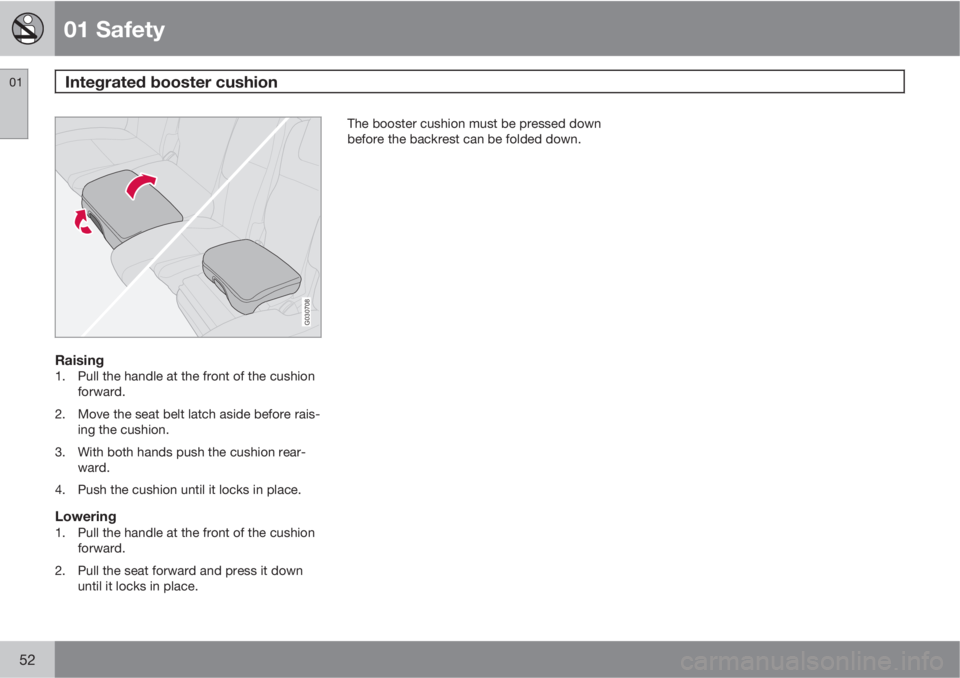
01 Safety
Integrated booster cushion 01
52
G030708
Raising1. Pull the handle at the front of the cushion
forward.
2. Move the seat belt latch aside before rais-
ing the cushion.
3. With both hands push the cushion rear-
ward.
4. Push the cushion until it locks in place.
Lowering1. Pull the handle at the front of the cushion
forward.
2. Pull the seat forward and press it down
until it locks in place.The booster cushion must be pressed down
before the backrest can be folded down.
Page 55 of 310

01 Safety
01
53
Page 56 of 310
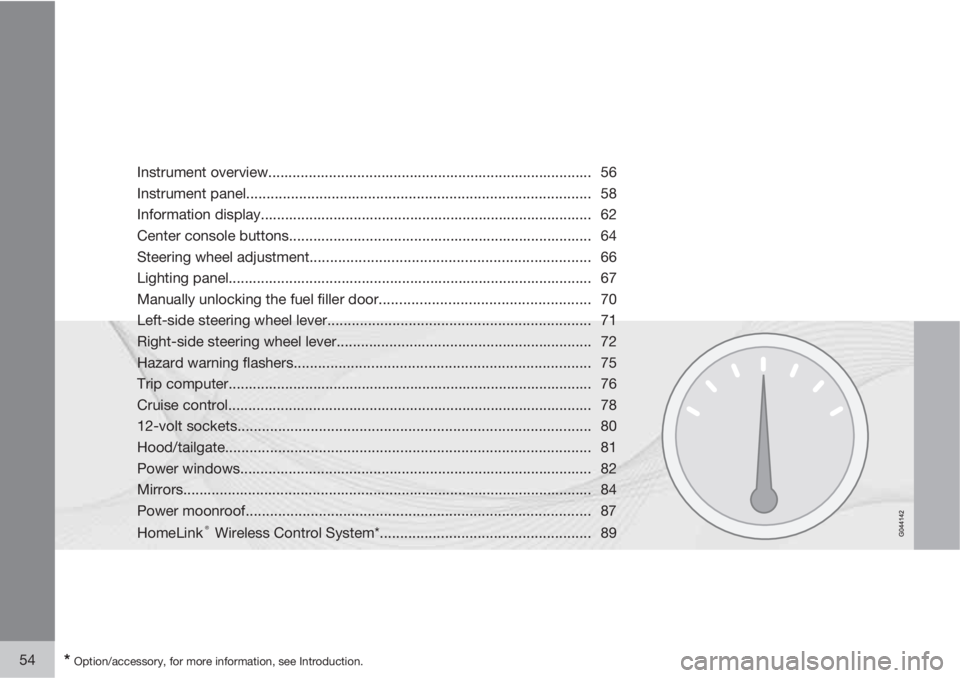
54* Option/accessory, for more information, see Introduction.
Instrument overview................................................................................ 56
Instrument panel..................................................................................... 58
Information display.................................................................................. 62
Center console buttons........................................................................... 64
Steering wheel adjustment..................................................................... 66
Lighting panel.......................................................................................... 67
Manually unlocking the fuel filler door.................................................... 70
Left-side steering wheel lever................................................................. 71
Right-side steering wheel lever............................................................... 72
Hazard warning flashers......................................................................... 75
Trip computer.......................................................................................... 76
Cruise control.......................................................................................... 78
12-volt sockets....................................................................................... 80
Hood/tailgate.......................................................................................... 81
Power windows....................................................................................... 82
Mirrors..................................................................................................... 84
Power moonroof..................................................................................... 87
HomeLink
® Wireless Control System*.................................................... 89
Page 57 of 310

INSTRUMENTS AND CONTROLS
Page 58 of 310
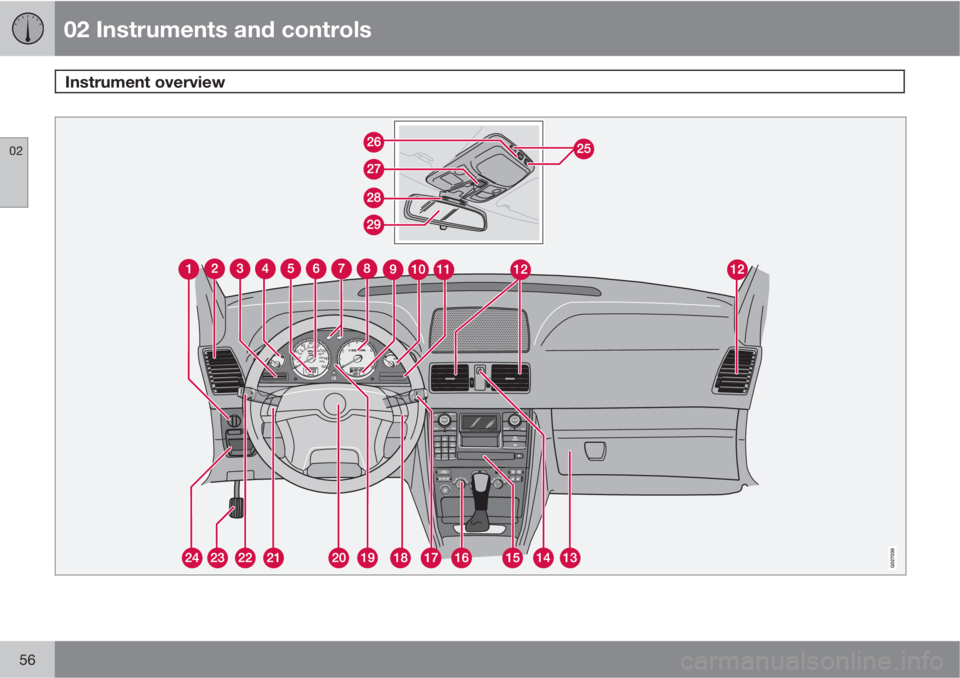
02 Instruments and controls
Instrument overview
02
56
Page 59 of 310
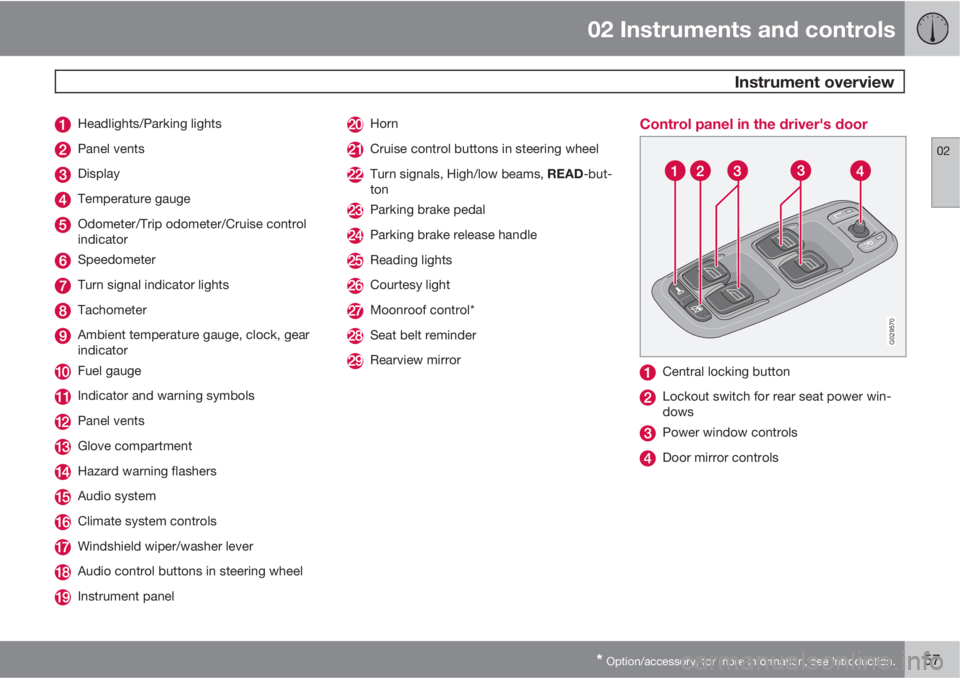
02 Instruments and controls
Instrument overview
02
* Option/accessory, for more information, see Introduction.57
Headlights/Parking lights
Panel vents
Display
Temperature gauge
Odometer/Trip odometer/Cruise control
indicator
Speedometer
Turn signal indicator lights
Tachometer
Ambient temperature gauge, clock, gear
indicator
Fuel gauge
Indicator and warning symbols
Panel vents
Glove compartment
Hazard warning flashers
Audio system
Climate system controls
Windshield wiper/washer lever
Audio control buttons in steering wheel
Instrument panel
Horn
Cruise control buttons in steering wheel
Turn signals, High/low beams, READ-but-
ton
Parking brake pedal
Parking brake release handle
Reading lights
Courtesy light
Moonroof control*
Seat belt reminder
Rearview mirror
Control panel in the driver's door
G029570
Central locking button
Lockout switch for rear seat power win-
dows
Power window controls
Door mirror controls
Page 60 of 310
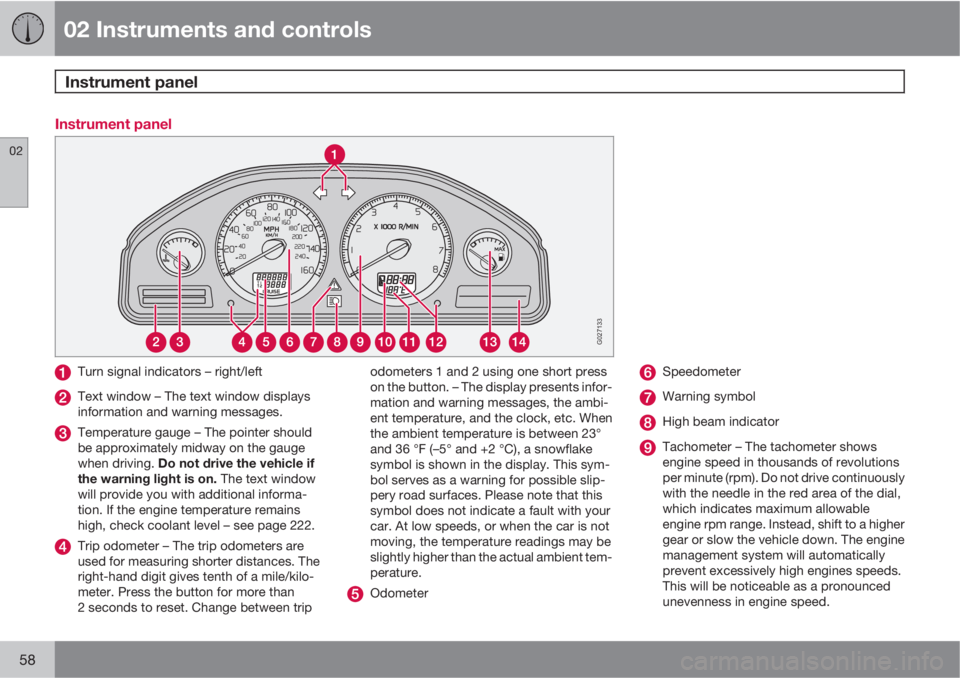
02 Instruments and controls
Instrument panel
02
58
Instrument panel
G027133
Turn signal indicators – right/left
Text window – The text window displays
information and warning messages.
Temperature gauge – The pointer should
be approximately midway on the gauge
when driving. Do not drive the vehicle if
the warning light is on. The text window
will provide you with additional informa-
tion. If the engine temperature remains
high, check coolant level – see page 222.
Trip odometer – The trip odometers are
used for measuring shorter distances. The
right-hand digit gives tenth of a mile/kilo-
meter. Press the button for more than
2 seconds to reset. Change between tripodometers 1 and 2 using one short press
on the button. – The display presents infor-
mation and warning messages, the ambi-
ent temperature, and the clock, etc. When
the ambient temperature is between 23°
and 36 °F (–5° and +2 °C), a snowflake
symbol is shown in the display. This sym-
bol serves as a warning for possible slip-
pery road surfaces. Please note that this
symbol does not indicate a fault with your
car. At low speeds, or when the car is not
moving, the temperature readings may be
slightly higher than the actual ambient tem-
perature.
Odometer
Speedometer
Warning symbol
High beam indicator
Tachometer – The tachometer shows
engine speed in thousands of revolutions
per minute (rpm). Do not drive continuously
with the needle in the red area of the dial,
which indicates maximum allowable
engine rpm range. Instead, shift to a higher
gear or slow the vehicle down. The engine
management system will automatically
prevent excessively high engines speeds.
This will be noticeable as a pronounced
unevenness in engine speed.